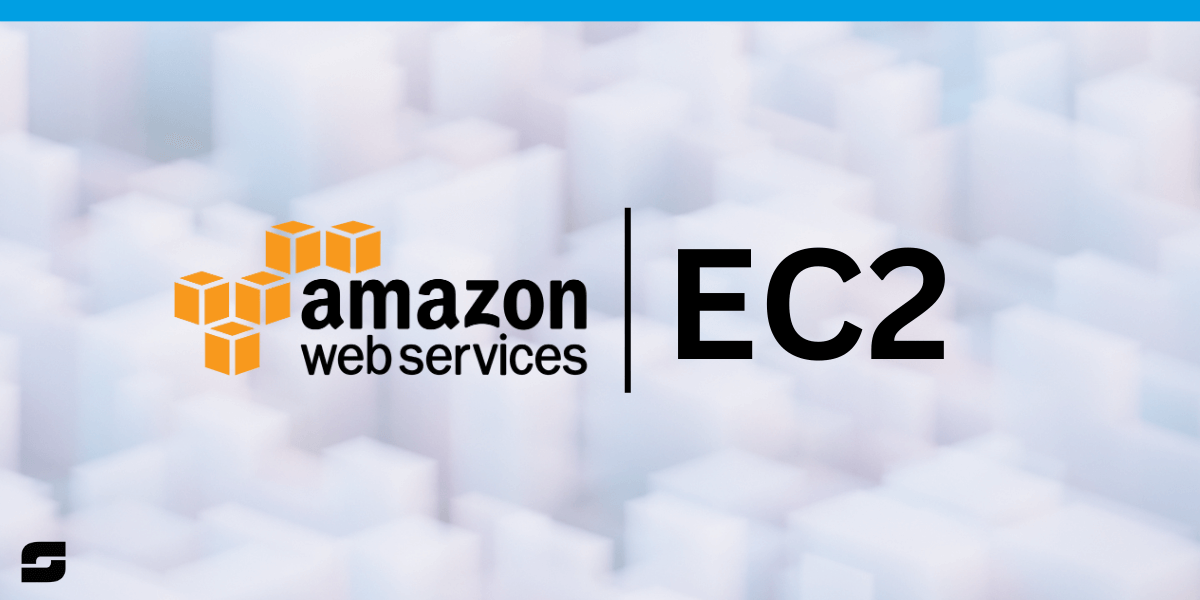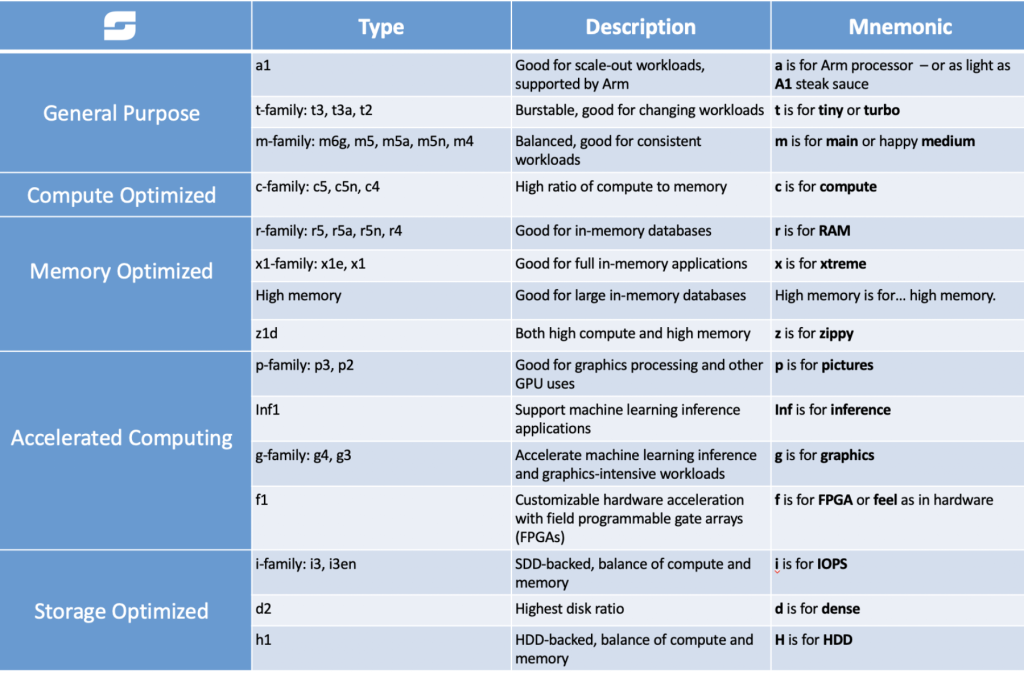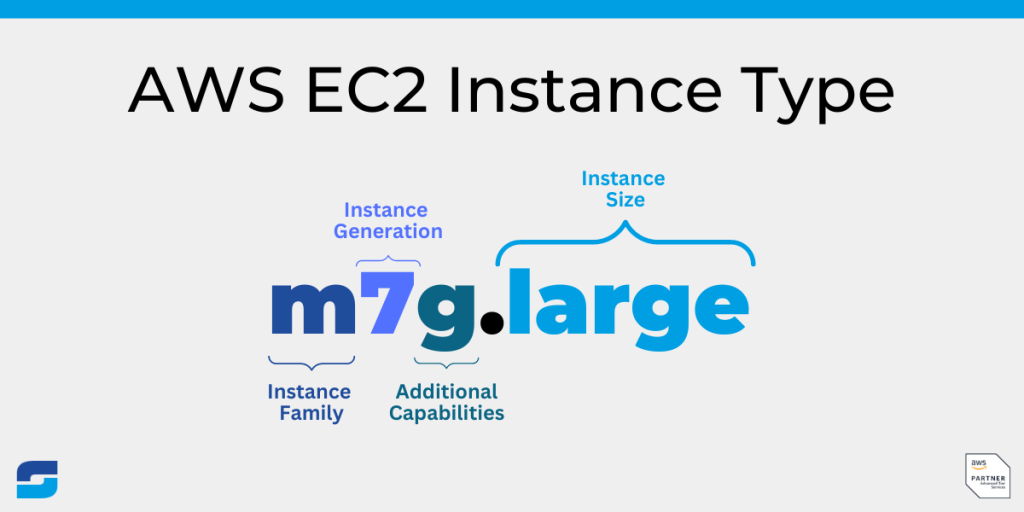
Amazon Elastic Compute Cloud Instance, also known as an EC2 Instance, is a cloud computing service that provides resizable compute capacity in the cloud.
EC2 instance types refer to the various configurations of virtual server instances that are available on the Amazon Web Services (AWS) platform. These instances are differentiated by the amount of:
- Compute
- Memory
- Storage resources
AWS provides multiple types of Amazon EC2 instances for various use cases.
- General Purpose – For a wide range of workloads, General Purpose instances provide balanced CPU, RAM, storage, and networking performance.
- Compute Optimized – Compute-optimized instances are appropriate for workloads requiring high-performance processing capacity, such as batch processing and high-traffic web servers.
- Memory Optimized – Memory-optimized instances are ideal for workloads that require large data sets to be processed in memory.
- Storage Optimized – Storage-optimized instances enable rapid, sequential read and write access to massive amounts of data stored on local storage. They enable applications to perform tens of thousands of random I/O operations per second (IOPS) while maintaining low latency.
- Accelerated Computing – To perform specific tasks, such as graphics processing or video rendering, accelerated computing instances use co-processing or hardware accelerators.
| General Purpose | Compute Optimized | Memory Optimized | Accelerated Computing | Storage Optimized |
| Enterprise-level apps, mobile, and game dev environments | Processor with high computing power, scientific modeling, complex calculations | Processing large datasets, big data analytics | GPU, FPGA (graphic cards) | Data caching, low latency, high speed, data analytics, data warehousing |
EC2 Instance families
Amazon EC2 offers a wide range of options across the different instance types, each with one or more size options and organized into distinct instance “families” optimized for specific types of applications.
As a starting point for application performance testing, we recommend that you work with a trusted AWS Partner to assess the requirements of your applications and select the appropriate instance family.

Amazon EC2 also provides different instance sizes for each instance family, allowing you to choose the best one for your workload.
- Nano
- Micro
- Small
- Medium
- Large
- Xlarge
- 2Xlarge
Getting just enough compute power for a workload is the key to save money without sacrificing performance.
Lets Summarize

Family – various instance types with resources for various use cases.
Generation – AWS uses these numbers to show which technologies are which as they phase out older ones and bring in new ones with more resources.
Size – Both resources and their prices increase in a linear fashion.
NOTE: It’s worth noting that the pricing for EC2 instances varies based on the instance type, as well as the region and availability zone that you choose. Additionally, there are other factors that can affect the performance of your EC2 instances, such as the operating system, networking, and storage configuration.
General Purpose
If you are new to AWS or the cloud in general, GPI is a good option. These types of instances are used in web server services, mobile and game development environments, and enterprise-level applications. GPI provide a diverse range of computing power, memory, and storage.
Another significant distinction between general purpose instances is the use of fixed EC2 instances versus burstable instances.
Fixed EC2 instances VS Burstable instances
Burstable instances differ from fixed instances in that fixed instances provide fixed CPU resources, whereas burstable instances provide a “baseline” level of performance per vCPU. CPU credits are earned as long as the instance operates below the baseline level.
General-purpose Types
A1 instance – Based on ARM processors and is suitable for web servers, containerized microservices, and applications that use open-source tools like Java or Python.
M5 instance – Part of the latest generation of general-purpose instances and uses the Intel Xeon Platinum 8175 3.1GHz processor. These instances provide a good balance of computing, networking, and memory and are ideal for small to medium-sized databases and data processing workloads. They can also be used as a backend server for applications like SAP or SharePoint.
T3/T3a instance – Available in both Intel and AMD processors and is a burstable instance option. These instances are a cost-effective and less powerful option compared to the M5 fixed instances. They are mostly used for long-lasting application instances like websites, web applications, scheduling jobs, and code repositories.
Mac instances – Designed to run on-demand macOS workloads in the cloud. By using Mac instances, you can develop apps for the iPhone, iPad, Apple Watch, Apple TV, and Safari. These instances are powered by AWS Nitro with core i7 processors, and all versions of macOS are available for use.
Conclusion
Choosing the right Amazon EC2 instance type can be a time-consuming and error-prone process, but it’s crucial for optimizing your cloud performance and avoiding unnecessary costs. With so many instance types available, it’s important to select the one that best fits your application’s needs.
However, selecting an instance type that’s larger than what you need can quickly deplete your cloud budget and limit engineering innovation. This can lead to a domino effect of negative consequences, such as passing on high costs to customers, increased prices, and revenue loss.
To avoid this downward spiral, it’s essential to conduct an AWS Well-Architected Review for optimal cloud performance.
EC2 instance types are an important consideration when deploying workloads on AWS. By selecting the appropriate instance type for your workload, you can ensure that you have the necessary compute, memory, and storage resources to run your application efficiently and cost-effectively.